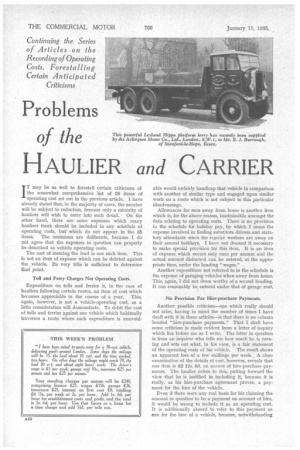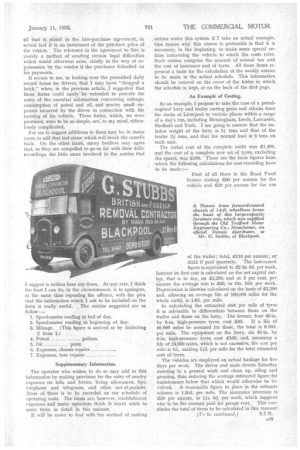HAULIER and CARRIER I T may be as well to forestall
Page 62

Page 63

If you've noticed an error in this article please click here to report it so we can fix it.
certain criticisms of the somewhat comprehensive list of 38 items of operating cost set out in the previous article. I have already stated that, in the majority of cases, the number will be subject to reduction, because only a minority of hauliers will wish to enter into such detail. On the other hand, there are some expenses which many hauliers think should be included in any schedule of operating costs, but' which do not appear in the 38 items. The omissions are deliberate, because I do not agree that the expenses in question can properly be described as vehicle operating costs.
The cost of insuring the load is one such item. This is not an item of expense which can be debited against the vehicle. Its very title is sufficient to determine that point.
Toll and Ferry Charges Not Operating Costs.
Expenditure on tolls and ferries is, in the case of hauliers following certain routes, an item of cost which becomes appreciable in the course of a year. This, again, however, is not a vehicle-operating cost, as a little consideration will demonstrate. To debit the cost of tolls and ferries against one vehicle which habitually traverses a route where such expenditure is unavoid able would unfairly handicap that vehicle in comparison with another of similar type and engaged upon similar work on a route which is not subject to this particular disadvantage.
Allowances for men away from home is another item which is, for the above reason, inadmissible amongst the data relating to operating costs. There is no provision in the schedule for holiday pay, by which I mean the expense involved in finding substitute drivers and statutory attendants when the regular workers are away on their annual holidays. I have not deemed it necessary to make special provision for this item. It is an item of expense which occurs only once per annum and the actual amount disbursed can be entered, at the appropriate time, wider the heading "wages."
Another expenditure not referred to in the schedule is the expense of garaging vehicles when away from home. This, again, I did not deem worthy of a second heading. It can reasonably be entered under that of garage rent.
No Provision For Hire-purchase Payments.
Another possible criticism—one which really should not arise, having in mind the number of times I have dealt with it in these articles—is that there is no column headed "hire-purchase payments." That I shall have some criticism is made evident from a letter of inquiry which lies before me as I write. The letter in question is from an inquirer who tells me how much he is earning and sets out what, in his view, is a fair statement of the operating costs of his vehicle. The result shows an apparent loss of a few shillings per week. A close examination of the details of cost, however, reveals that one item is £3 17s. 6d. on acount of hire-purchase payments. The haulier refers to this, putting forward the view that he is justified in including it, because it is really, as his hire-purchase agreement proves, a payment for the hire of the vehicle.
Even if there were any real basis for his claiming the amount in question to he a payment on account of hire, it would be wrong to include it as an operating cost. It is additionally absurd to refer to this payment as one for the hire of a vehicle, because, notwithstanding all that is stated in the hire-purchase agreement, in actual fact it is an instalment of the purchase price of the vehicle. The reference in the agreement to hire is merely a method of evading certain legal difficulties which would otherwise arise, chiefly in the way of repossession by the vendor if the purchaser defaulted on his payments.
It occurs to me, in looking over the prescribed daily record forms for drivers, that I may have "dropped a brick" when, in the previous article, I suggested that these forms could easily be extended to provide for entry of the essential information concerning mileage, consumption of petrol and oil, and sundry small expenses incurred by the driver in connection with the running of his vehicle. These forms, which, we were promised, were to be so simple, are: to my mind, ridiculously complicated.
For me to suggest additions to them may be, in many cases, to add that last straw which will break the camel's back. On the other hand, many hauliers may agree that, as they are compelled to go so far with their daily recordings, the little more involved in the entries that I suggest is neither here nor there. At any rate, I think the least I can do, in the circumstances, is to apologize, at the same time repeating the offence, with the plea that the information which I ask to be included on the form is really useful. The entries suggested are as follow :—
1. Speedometer reading at 'end of day.
2. Speedometer reading at beginning of day.
3. Mileage. (This figure is arrived at by deducting 2 from 1.) 4. Petrol gallons.
5. Oil pints.
6. Expenses, chassis repairs 7. Expenses, tyre repairs Supplementary Information
The operator who wishes to do so may add to this information by making provision for the entry of sundry expenses on tolls and ferries, living allowances, tips, telephone and telegrams, and other out-of-pockets. None of these is to be recorded on our schedule of operating costs. The items are, however, eztablishinent expenses and many operators think it -IWorth while to enter them in detail in this manner.
It will be easier to deal with the method of making entries under this system if I take an actual example. One reason why this course is preferable is that it is necessary, in the beginning, to make some special entries concerning the vehicle to which the costs refer. Such entries comprise the amount of • annual tax and the cost of insurance and of tyres. All these items represent a basis for the calculation of the weekly entries to be made in the actual schedule. This information should be entered on the cover of the folder in which the schedule is kept, or on the back of the first page.
An Example of Costing.
As an example, I propose to take the case of a petrolengined lorry and trailer carting grain and oikake from the docks at Liverpool to various places within a range of a day's rim, including Birmingham, Leeds, Lancaster, Sheffield and York. I am going to assume that the Unladen weight of the lorry is 5 tons and that of the trailer 3i -tons, and that the normal load is 6 tons on
each unit.
The initial cost of the complete outfit was £1,38U,
and the cost of a complete new set of tyres, excluding the spares, was £180. These are the basic figutes 'rem -which the following Calculations for cost recording have
to be made First Of all there is the Road Fund licence costing £90 per annum for the vehicle and £20 per annum for the use
of the trailer ; total, £110 per annum; or £121 if paid quarterly. The last-named figure is equivalent to £2 6s. 6d. per week. Interest on first cost is calculated on the net capital outlay, that is to say,, on £1,200, and at 3 per cent, per, annum the average rate is £36, or 13s. 10d, per week. Depreciation is likewise calculated on the basis of £1,200 and, allowing an average life of 180,000 miles for the whole outfit, is 1.6d. per mile.
En calculating the estimated cost per mile of tyres it is advisable to differentiate between those on the trailer and those on the lorry. The former, four 40-in.
by 9-in, high-pressure tyres, cost £80. If a life of 40,000 miles be assumed for these, the total is 0.50d. per mile. The equipment on the lorry, six 40-in. by 8-in, high-pressure tyres, cost £100, and, assuming a life of 24,000 miles, which is not excessive, the cost per mile is 1d., making 1id, per mile for the total estimated cost of tyres.
The vehicles are employed on actual haulage for five days per week. The driver and mate devote Saturday morning to a general wash and clean up, oiling and greasing, thus reducing the average estimated figure for maintenance below that which would otherwise be involved. A reasonable figure to place in the estimate column is 1.30d. per mile. The insurance premium is £30 per annum, or 11s. 6d. per week, which happena also to be the amount paid for garage rent This concludes the total of items to be calculated in this manner: (To be continued.) S.T.R.




































































































